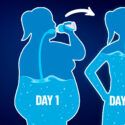It’s been described as stepping into an underwater cathedral. Here you’ll encounter a tunnel, arch and breathtaking scenery. But this majestic structure can swallow you whole and leave you as one of the hundreds who have succumbed to this diver’s cemetery.
The Blue Hole is a 120 m (394 ft) deep sinkhole located at the edge of the Red Sea in the Sinai Peninsula of Egypt. It formed during the last ice age, thousands of years ago when water eroded rock until it became unstable and collapsed. Then water, sediment and sand settled into the hole. For more than 30 years, this sinkhole has been a popular scuba diving and snorkeling site. But this is a perilous place where many people get in, but only a few can get out. What is the martini effect? Which oxygen tanks should you avoid? And, how could following a light kill you?
Step 1. Don’t Go to the Light
The trickiest part of the dive is under the arch. This is where most of the Blue Hole’s 200 deaths have occurred. At such depths, visibility isn’t great, and you’d see a light emerging from the distance. You might follow it, thinking it’s the surface, but it isn’t. It’s the opening of a 26 m (85 ft) tunnel that’d lead you straight to the vastness of the Red Sea where you can easily get lost. Or worse. If you’re planning to visit the Blue Hole, aim on going between June and August to take advantage of the clearer water.
Step 2. Pick Your Tank
You planned your summer vacation and you’re ready to pass under that infamous arch. Wait, that regular 10.4 L tank won’t bring you back to shore safe and sound. Many divers are fooled by the relatively short length of the arch tunnel. However, it slopes downward, adding several meters to the depth. You’ll end up spending several minutes in the tunnel. By the time you exit it, you’d have consumed about 60% of your regular tank and won’t have enough to make a safe ascension. If you want to descend lower than 50 m (164 ft), bring multiple tanks filled with a mix of oxygen, nitrogen and helium.
Step 3. Leave Extra Weight
You have your tank, now make sure that you aren’t carrying any extra weight. This could mess with your gear’s buoyancy regulation. Even pros make this deadly mistake. Diving instructor Yuri Lipski wanted to document his experience at the Blue Hole and went in wearing a helmet cam. The added weight of the camera made him descend too fast and too heavy for his buoyancy device to work and help him ascend. The miscalculation resulted in Lipski recording his own death.
Step 4. Know When to Go Up
Underwater you’re breathing at a much higher pressure than your body is used to. Once you reach a depth of 21 m (70 ft) you become vulnerable to nitrogen narcosis, also known as the martini effect. Much like being drunk, you might feel disoriented and confused. Your judgment can be a bit off, too. By this point, you’d be on borrowed time. If you go down deeper, you’ll lose consciousness and drown. This is your cue to inflate your buoyancy regulator to stop descending and start making your way up.
Step 5. Decompress Properly
You started to ascend but, again, not so fast. It should be slow and measured, at about 10 m (33 ft) per minute. Make frequent decompression stops so that your body can adapt to the changes in pressure. Doing it too quickly means nitrogen bubbles could form in your blood, causing debilitating pain in your joints. And that won’t be a good way of ending your dive. This experience was wild.
Sources
- Swimmers Beware: The Most Dangerous Waters On Earth (2022). The Rainforest Site.
- Top diver’s death casts long shadow over deep beauty of the Blue Hole. Bower, E. (2017). The Guardian.
- Why Divers Die When They Dive the Blue Hole in Dahab (2022). The Scuba Page.
- A Visit to the World’s Deadliest Dive Site. Großekathöfer, V. M. (2012). Spiegen International.
- Diver’s Cemetery: The Blue Hole of Dahab. Morton, E. (2022). Slate.

















